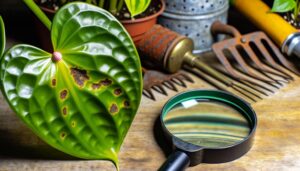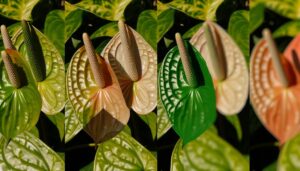Solving the Problem of Anthurium Plant Leaves Turning Brown
To stop your Anthurium’s leaves from turning brown, make sure you’re watering properly. Water when the top inch of soil feels dry, using room-temperature, filtered water.
The soil should be well-draining and the pot must have drainage holes. Maintain humidity around 65-80°F, and keep the plant in bright, indirect light.
Check for pests and treat them with neem oil or insecticidal soap. Use a balanced fertilizer and routinely inspect for signs of root rot by ensuring well-aerated soil and avoiding overwatering.
With these steps, you’ll improve your plant’s health significantly. To optimize these practices and tackle advanced issues, there’s more to explore.
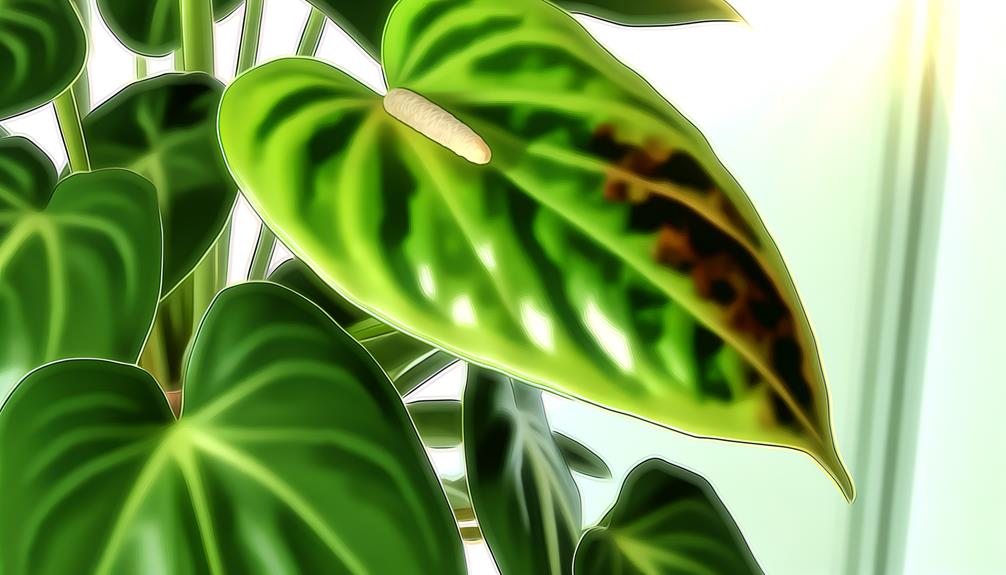
Key Takeaways
- Ensure consistent watering and let the top inch of soil dry before rewatering.
- Use a well-draining potting mix and a pot with drainage holes to prevent root rot.
- Maintain bright, indirect sunlight and avoid direct exposure.
- Regularly check for pests like spider mites, aphids, and mealybugs and treat with neem oil or insecticidal soap.
- Keep soil pH between 5.5 and 6.5 for optimal nutrient absorption.
Incorrect Watering

Incorrect watering is one of the main reasons why your Anthurium plant’s leaves may turn brown. To maintain proper hydration, you need to establish a consistent watering schedule. Anthuriums thrive in well-moistened, but not waterlogged, soil.
Overwatering can lead to root rot, depriving the plant of oxygen, while underwatering causes dehydration and stress.
Aim to water your Anthurium when the top inch of soil feels dry to the touch. Use room-temperature, filtered water to avoid shocking the roots with extreme temperatures or harmful minerals.
Poor Drainage
Poor drainage can cause anthurium leaves to turn brown by suffocating the roots and promoting root rot.
You should use a well-aerated soil mix, such as one containing peat, pine bark, and perlite, to guarantee proper drainage.
Additionally, select a pot with drainage holes to prevent water from accumulating at the bottom.
Soil Type Matters
Your Anthurium’s leaves might be turning brown due to soil with insufficient drainage, which can lead to root rot and nutrient deficiencies.
It’s essential to use a well-draining potting mix to maintain proper pH balance and facilitate nutrient absorption. A mix containing orchid bark, perlite, and peat moss can improve aeration and support root health.
Confirm the soil is slightly acidic, with a pH between 5.5 and 6.5, to maximize the plant’s ability to absorb essential nutrients. Avoid compacted soils, as they restrict airflow, leading to waterlogged roots and brown leaves.
Regularly check the soil’s texture and drainage capabilities to guarantee it supports your Anthurium’s specific needs. Proper soil management can prevent many common issues.
Effective Pot Choice
Selecting the right pot ensures proper drainage, which is crucial for preventing waterlogged roots and brown leaves on your Anthurium plant.
Make sure your pot has sufficient drainage holes to uphold root health and prevent root rot.
Match the pot size to the plant size; a pot that’s too big can hold onto excess moisture, while a pot that’s too small can hinder root growth.
Use a well-aerated potting mix to promote adequate drainage.
Avoid pots without drainage holes as they encourage water accumulation, resulting in leaf discoloration.
Regularly monitor your fertilizer use; excessive fertilization can worsen drainage issues and intensify leaf browning.
Making the right pot selection plays a critical role in sustaining healthy roots and vibrant leaves on your Anthurium.
Humidity Levels
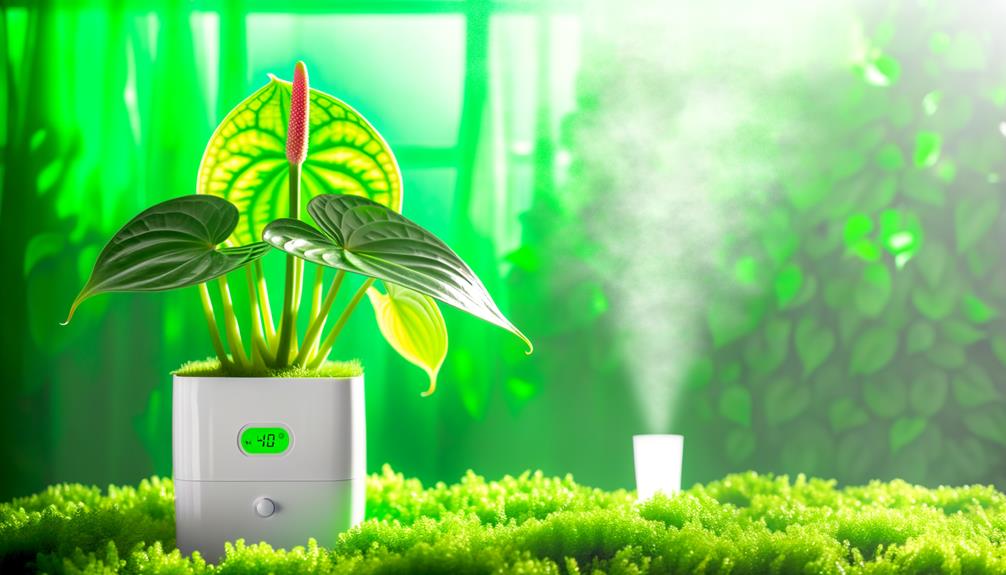
Maintaining adequate humidity levels is essential for preventing the browning of Anthurium plant leaves. Proper plant placement is critical to maintain a stable environment. Position your plant in a spot that meets its ventilation requirements but avoids direct airflow from vents or fans, as this can reduce humidity.
Enhance air circulation around the plant by using a small fan, which helps prevent fungal growth without excessively drying the air. Regular leaf misting can also elevate humidity levels, but make sure you do this in the morning to allow leaves to dry and avoid mold.
You can also utilize a humidity tray or a room humidifier to maintain ideal moisture levels, ideally around 70-80%, to keep your Anthurium thriving.
Temperature Stress
To prevent temperature stress, maintain an ideal range of 65-80°F for your Anthurium. You should avoid temperature extremes, as fluctuations outside this range can cause the leaves to turn brown.
Make sure the plant isn’t exposed to direct drafts or sudden changes in temperature.
Ideal Temperature Range
Anthurium plants flourish best within a temperature range of 65-80°F (18-27°C), and deviations from this range can lead to temperature stress, manifesting as brown leaves. You need to maintain this ideal temperature for their best growth benefits. Temperature regulation is essential; drastic fluctuations can disrupt the plant’s metabolic processes.
During colder months, bring your Anthurium indoors or use a heat mat to keep it within the desired range. Conversely, in warmer seasons, make sure it’s not exposed to direct sunlight for prolonged periods. Seasonal adjustments play a significant role in preventing temperature stress.
Avoiding Temperature Extremes
Ensuring your Anthurium doesn’t experience temperature extremes is crucial for preventing leaf browning and maintaining overall plant health.
Start by practicing temperature regulation to keep the environment between 65-80°F (18-27°C). Avoid placing your plant near drafty windows or heating vents, as sudden temperature fluctuations can cause stress.
Implement climate control by using a thermostat and hygrometer to monitor and adjust conditions precisely. Consistently maintaining ideal temperatures will support leaf health and reduce the likelihood of brown spots.
Additionally, avoid direct exposure to cold drafts during winter and excessive heat during summer. By focusing on meticulous plant care and creating a stable indoor climate, you’ll enhance your Anthurium’s resilience against temperature-induced stress.
Light Conditions
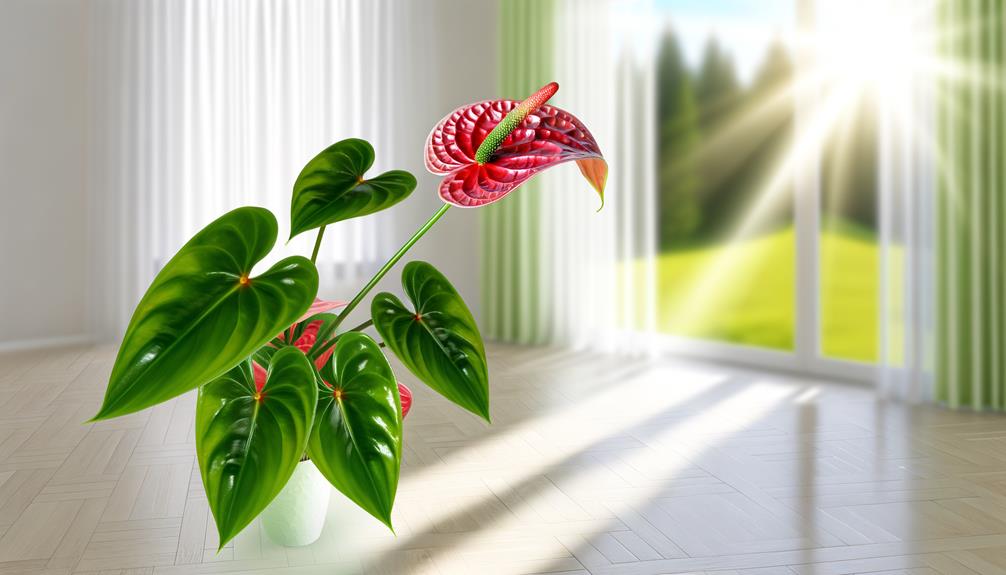
Providing your Anthurium with bright, indirect sunlight is crucial for preventing its leaves from turning brown. Proper light exposure directly influences the plant’s growth patterns and overall essentiality.
Too much direct sunlight can scorch the leaves, while insufficient light stunts growth and dulls leaf health. Aim to place your Anthurium near a north or east-facing window where it can receive ample filtered light.
If natural light is limited, consider using a grow light to meet its lighting requirements. Monitor your plant, adjusting its position as needed to ensure prime light conditions.
Nutrient Deficiencies
Nutrient insufficiencies can lead to your Anthurium’s leaves to change to a brown hue, indicating an imbalance in vital minerals like nitrogen, phosphorus, and potassium. These insufficiencies impede nutrient absorption, impacting plant growth and resulting in leaf discoloration, jeopardizing overall plant health.
To address this issue, make sure your Anthurium receives a balanced fertilizer. Here are key points to take into account:
- Nitrogen Insufficiency: Causes yellowing leaves that eventually turn brown.
- Phosphorus Insufficiency: Leads to dark patches on leaves before browning.
- Potassium Insufficiency: Results in yellowing edges that progress to brown.
- Iron Insufficiency: Causes interveinal chlorosis, turning leaves brown.
Regularly check soil pH and nutrient levels to maintain ideal conditions for your Anthurium’s health and vibrant foliage.
Pest Infestations
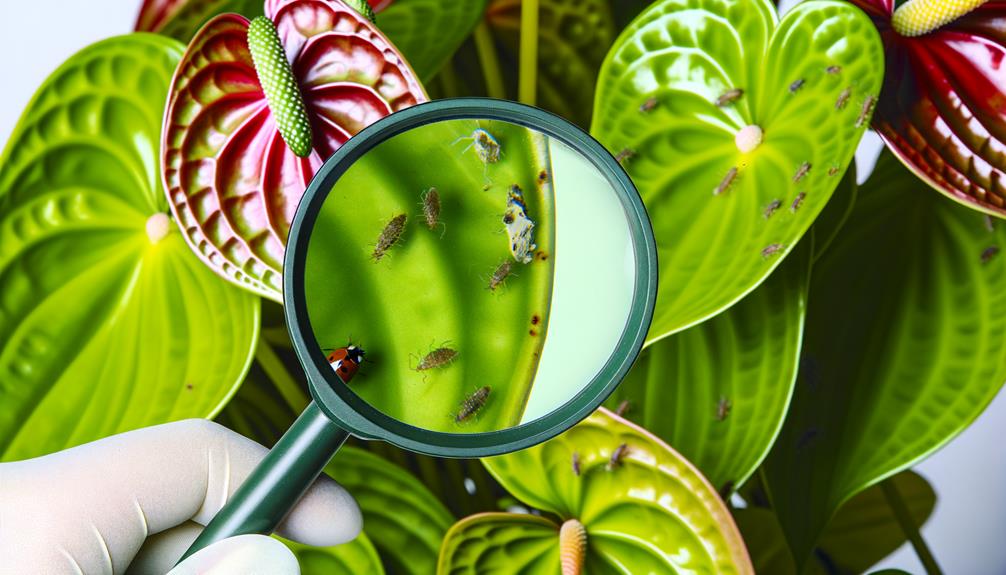
You might notice brown spots on Anthurium leaves caused by pests like spider mites, aphids, and mealybugs. Identifying these common pests early is important for effective pest control.
Use insecticidal soap or neem oil to manage infestations and prevent further damage.
Common Pests Identification
When diagnosing brown leaves on your Anthurium, it’s vital to identify common pests like spider mites, aphids, and mealybugs, which can cause significant harm to the plant. Accurate pest identification is key for maintaining plant health and implementing effective pest prevention. Look for these signs:
- Spider mites: Fine webbing on the undersides of leaves and tiny, moving dots.
- Aphids: Clusters of small, soft-bodied insects around new growth.
- Mealybugs: White, cotton-like masses on stems and leaves.
- Thrips: Tiny, slender insects causing silvery streaks on leaves.
Use natural remedies like neem oil or insecticidal soap for pest prevention. Regularly inspect your Anthurium to catch infestations early, ensuring healthier, more resilient plants.
Effective Pest Control
Combating pest infestations on your Anthurium involves implementing targeted treatments like neem oil, insecticidal soap, and natural predators to effectively manage and eliminate harmful pests.
Neem oil acts as a natural remedy, disrupting the pests’ life cycle, while insecticidal soap targets soft-bodied insects.
Introducing natural predators, such as ladybugs, can also enhance pest prevention by controlling aphid populations.
For organic solutions, regularly inspect your plants and remove any visible pests manually. Maintaining proper humidity and air circulation reduces pest attraction.
Adopting an integrated pest management approach assures long-term health for your Anthurium. Consistent monitoring and early intervention are key to successful pest management, preventing brown leaves and promoting vigorous growth.
Fungal Diseases
Have you observed brown spots spreading on your Anthurium leaves, indicating a potential fungal infection? Fungal diseases can severely damage your plant if not addressed promptly. Implementing fungal prevention and proper care is crucial.
To manage these diseases and ensure healthy growth, follow these steps:
- Guarantee sufficient air circulation: Poor ventilation fosters fungal growth.
- Water appropriately: Over-watering creates a damp environment, promoting fungi.
- Use fungicides: Apply a recommended fungicide to combat infection.
- Remove affected leaves: Prune and dispose of infected leaves to prevent spreading.
Regularly inspect your Anthurium for early signs of fungal issues. This proactive approach in disease management will help maintain the plant’s vibrant appearance and overall health.
Soil Quality
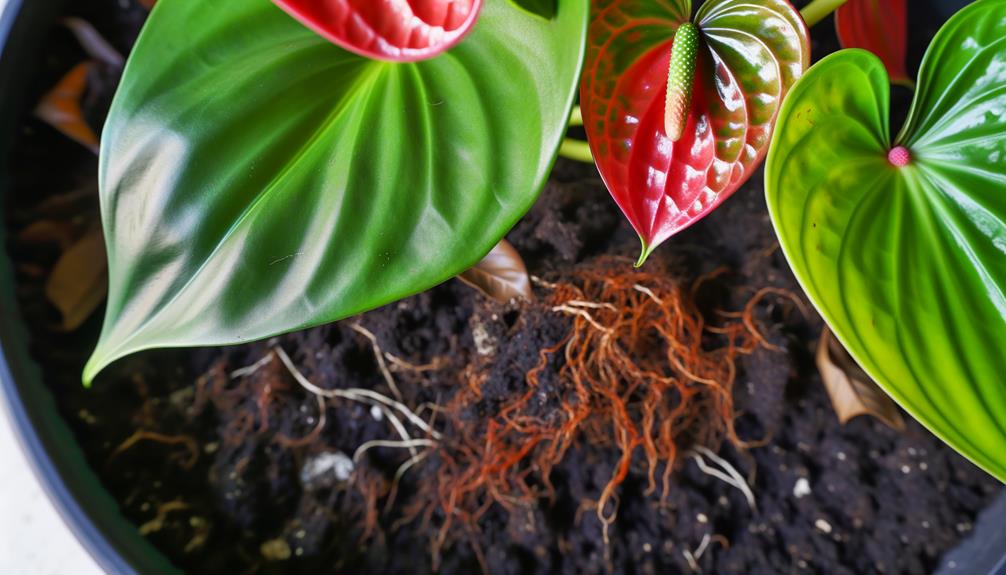
Ensuring top soil quality is crucial for the health and strength of your Anthurium plant. Start by maintaining a pH balance between 5.5 and 6.5, as this range optimizes nutrient absorption.
Use a well-draining potting mix rich in organic amendments like peat moss or compost to enhance soil health. These amendments improve soil structure and provide necessary nutrients.
Regularly test the soil’s pH and adjust using lime to raise or sulfur to lower it. Avoid heavy, compacted soils that hinder root growth and water drainage.
Root Rot
Root rot, a common issue in Anthurium plants, occurs when the roots are deprived of oxygen due to overwatering or poorly-draining soil. Early detection is essential to saving your plant. Look for symptoms like yellowing leaves, mushy roots, and a rotten smell.
To prevent root rot and guarantee a healthy root system, consider these prevention methods:
- Use well-draining soil to improve aeration techniques.
- Avoid overwatering; let the top inch of soil dry out before watering again.
- Make sure pots have adequate drainage holes to prevent water accumulation.
- Repot using a mix of orchid bark and perlite to enhance soil aeration.
Chemical Exposure
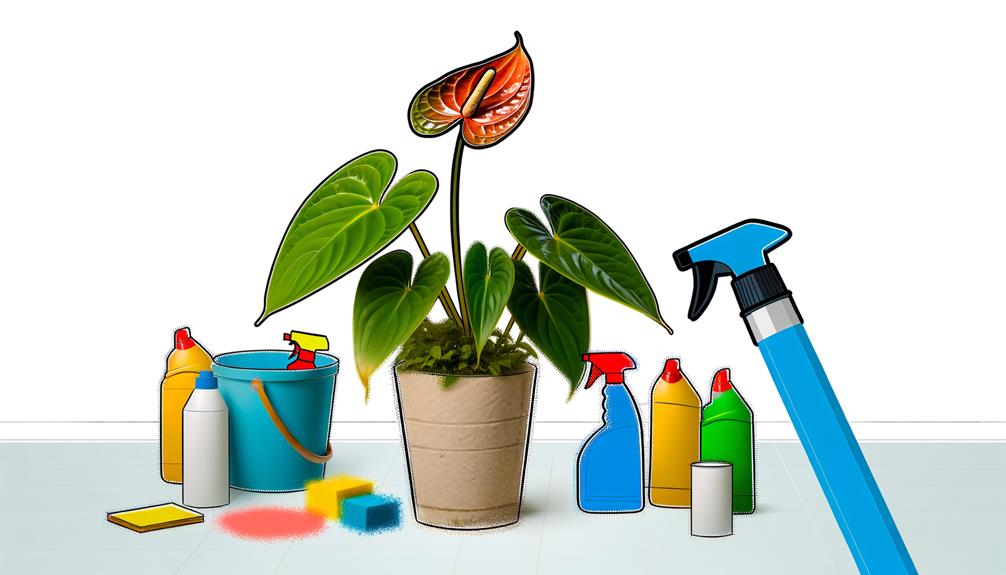
Exposure to chemicals, such as pesticides and household cleaners, can cause Anthurium leaves to turn brown, indicating damage to the plant’s cellular structure.
To minimize this risk, always make certain proper ventilation when using chemicals near your plants. Utilize protective gear such as gloves and masks to prevent direct contact with harmful substances. Effective prevention involves storing chemicals away from the Anthurium and opting for natural alternatives when possible.
Early detection of chemical exposure symptoms is essential; monitor your plant regularly for signs of distress. If you notice browning, promptly rinse the leaves with water to remove any residual chemicals and improve the overall health of your Anthurium.
Repotting Issues
Similarly, improper repotting techniques can lead to browning leaves in Anthurium plants, often due to root damage or unsuitable soil conditions. When repotting, you need to avoid these common repotting mistakes:
- Root bound: Confirm the plant isn’t root bound by gently loosening the roots before placing it in a new pot.
- Incorrect pot size: Select a pot that’s only slightly larger than the current one to prevent waterlogging and root rot.
- Inadequate soil mix: Utilize a well-draining soil mix, ideally one containing orchid bark, peat moss, and perlite.
- Transplant shock: Minimize root disturbance to reduce transplant shock, which can cause browning leaves.
Conclusion
So, you’ve adjusted your watering, confirmed proper drainage, and monitored humidity.
You’ve checked for temperature stress, optimized light conditions, and improved soil quality.
But are your anthurium’s leaves still turning brown? You might be missing one critical factor.
Could it be root rot lurking beneath the surface, or perhaps a chemical exposure you’ve overlooked?
Don’t repot just yet—sometimes the solution is hidden in the most unexpected place.
Dig deeper, and you’ll uncover the key to vibrant, healthy leaves.




